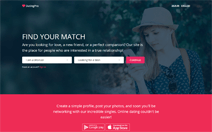Swipe, Like, or Voice Message: How to Choose the Right Dating App Interaction Mechanic
In the world of dating apps, it often begins with a thumb. A swipe to the right — and suddenly, two strangers are one step closer to something more. The simplicity of this gesture made it iconic. But what if simplicity comes at a cost?
As dating platforms evolve, so do their mechanics. Swipe-based interfaces dominate for a reason, but they’re no longer the only — or always the best — choice. Likes offer depth. Voice messages bring humanity. And each option tells a very different story about the kind of experience you’re building.
If you’re launching a dating app or redesigning your current one, understanding how users connect and how that affects monetization is not optional — it’s your growth engine.
Let’s explore the three most popular mechanics that shape the heartbeat of dating platforms today.
Swipe: instant gratification, fading attention
Swipe mechanics are addictive by design. Users move through profiles in seconds, making quick decisions based on first impressions. This format mimics the behavior of social feeds and slot machines — fast, repetitive, rewarding.
It fuels high engagement. Users feel active, entertained, and constantly in motion. For apps targeting younger audiences, swiping is an expected standard — and not offering it can lead to friction.
But here’s the catch: swiping creates matches that often lack substance. Many users swipe without reading bios, leading to shallow interactions and fast drop-offs. Worse, since most interactions happen before any meaningful connection, it’s harder to monetize post-swipe behavior.
That’s why apps relying on swipes often monetize indirectly:
» limiting daily swipes,
» unlocking who liked you,
» offering paid boosts or superlikes.
It works — to a degree. But swipe-first models demand constant engagement and novelty to avoid user fatigue.
Like: slower pace, higher quality
Unlike swiping, liking typically involves more thought. The user spends time reading a profile, viewing photos, and then decides to like — often with more intention. This slower pace brings a different kind of energy to the platform.
While likes may feel “old school,” they can build trust. They create space for more serious users, better filtering, and ultimately, more satisfying connections.
From a monetization perspective, likes are versatile. You can
• limit them to create scarcity,
• offer premium visibility,
• enable private or hidden likes for paid users.
The result? Lower bounce rates, fewer spam accounts, and stronger user retention.
This mechanic is especially effective for niche platforms: dating apps for professionals, over-30 singles, parents, or those looking for long-term relationships. If your platform is built around compatibility over instant chemistry, likes are a strong foundation.
Voice messages: connection you can hear
Now imagine this: instead of a text or a picture, your first impression is someone’s voice. A tone, an accent, a laugh. That’s the power of voice messaging in dating apps — and it’s changing the game.
Voice creates intimacy. It humanizes the experience in ways text cannot. Users feel they’re connecting with real people — not just polished profiles. This can break barriers faster, especially in communities where trust and authenticity matter.
However, the voice feature isn’t for everyone. Some users may hesitate to record themselves. And voice adds complexity: audio moderation, increased storage needs, and the potential for inappropriate content all require thoughtful implementation.
Yet the upside is real. Voice messages are powerful monetization tools:
» allow sending voice before matching,
» enable premium “voice intros,”
» offer exclusive audio replies or reactions.
For apps looking to differentiate, especially in emotionally-driven or community-based niches, voice can be a game-changer.
Choosing the right model
The mechanic you choose is more than a feature — it’s a brand statement.
Swiping says: “fast, fun, easy.”
Liking says: “curated, intentional, serious.”
Voice says: “personal, human, different.”
So ask yourself: what kind of emotional experience are you creating?
What behaviors do you want to encourage?
And how does your monetization align with that?
If you’re unsure, a hybrid model may work — swiping for initial engagement, likes for deeper interest, and voice for meaningful differentiation. But each must feel intentional. Forced combinations confuse users and dilute value.
Real love meets real strategy
In dating, first impressions matter. In apps — even more. But it’s the mechanics behind the screen that shape the journey.
Do users feel seen? Do they feel safe? Do they feel heard — literally?
Your interaction model defines not just how people connect, but whether they come back. And whether they pay.
If you’re building a dating app and want to test the right interaction mechanics, the Dating Pro team is here to help — with UX strategy, A/B testing, voice integration, and monetization blueprints that turn clicks into connections (and revenue).
Because in this game, the right mechanic isn’t just a feature. It’s your competitive edge.
FAQ: Swipe vs Like vs Voice Messaging in Dating Apps
What are the main interaction types in dating apps?
The three most common interaction mechanics in dating apps are swiping, liking, and voice messaging. Each mechanic creates a different user experience and supports specific engagement and monetization strategies.
How does swiping work in dating apps?
Swiping allows users to quickly browse through profiles, swiping right to express interest and left to skip. It’s highly engaging and encourages fast decision-making, but may lead to shallow matches and lower user retention.
What is the difference between swipe and like in dating apps?
Swiping is designed for speed and mass interaction, while liking usually reflects a more thoughtful user action. Liking encourages deeper engagement and can lead to more meaningful connections, especially on niche or serious dating platforms.
What are the benefits of using voice messaging in dating platforms?
Voice messaging adds a human layer to user interaction, allowing users to hear tone, emotion, and personality. This can increase trust, improve authenticity, and differentiate your app from competitors using only text or photo-based interactions.
How do dating apps monetize swipe mechanics?
Swipe-based apps monetize through daily swipe limits, premium boosts, rewind features, and “see who liked you” options. These microtransactions encourage users to pay for more visibility and faster matches.
How can dating apps monetize likes?
Likes can be monetized by introducing limits on free likes, offering superlikes, or making likes private until a user upgrades to premium. This creates scarcity and drives conversion to paid plans.
Can voice messages be used for monetization?
Yes. Voice messages can be offered as a premium feature — such as voice intros before matching, sending audio messages without a match, or receiving “voice replies” only in paid tiers.
Which interaction mechanic leads to higher user engagement?
Swiping tends to produce the highest short-term engagement due to its addictive nature. However, liking and voice messaging often lead to higher quality interactions and longer session duration — key for long-term retention and monetization.
Should I combine multiple interaction types in my dating app?
Many successful apps use a hybrid model, combining swipes for initial discovery, likes for deeper engagement, and voice for authenticity. This layered approach allows for broader audience targeting and more monetization pathways.
How do I choose the best interaction model for my dating app?
It depends on your audience and goals.
-
Swiping suits fast-paced, high-volume apps (e.g., for Gen Z).
-
Liking fits serious or niche dating communities.
-
Voice messaging works best in apps focused on authenticity, emotional connection, or privacy.




